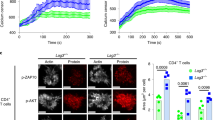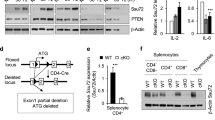Abstract
In addition to triggering the activation of B- or T-cell antigen receptors, the binding of a ligand to its receptor at the cell surface can sometimes determine the physiological outcome of interactions between antigen-presenting cells, T and B lymphocytes. The protein SLAM (also known as CDw150), which is present on the surface of B and T cells, forms such a receptor–ligand pair as it is a self-ligand. We now show that a T-cell-specific, SLAM-associated protein (SAP), which contains an SH2 domain and a short tail, acts as an inhibitor by blocking recruitment of the SH2-domain-containing signal-transduction molecule SHP-2 to a docking site in the SLAM cytoplasmic region. The gene encoding SAP maps to the same area of the X chromosome as the locus for X-linked lymphoproliferative disease (XLP) and we found mutations in the SAP gene in three XLP patients. Absence of the inhibitor SAP in XLP patients affects T/B-cell interactions induced by SLAM, leading to an inability to control B-cell proliferation caused by Epstein–Barr virus infections.
This is a preview of subscription content, access via your institution
Access options
Subscribe to this journal
Receive 51 print issues and online access
$199.00 per year
only $3.90 per issue
Buy this article
- Purchase on SpringerLink
- Instant access to full article PDF
Prices may be subject to local taxes which are calculated during checkout









Similar content being viewed by others
References
Cocks, B. G. et al. Anovel receptor involved in T-cell activation. Nature 376, 260–263 (1995).
Aversa, G. et al. SLAM and its role in T cell activation and Th cell responses. Immunol. Cell Biol. 75, 202–205 (1997).
Aversa, G., Chang, C. J., Carballido, J. M., Cocks, B. G. & de Vries, J. E. Engagement of the signalling lymphocytic activation molecule (SLAM) on activated T cells results in IL-2-independent, cyclosporin A-sensitive T cell proliferation and IFN-gamma production. J. Immunol. 158, 4036–4044 (1997).
Carballido, J. M. et al. Reversal of human allergic T helper 2 responses by engagement of signaling lymphocytic activation molecule. J. Immunol. 159, 4316–4321 (1997).
Isomaki, P. et al. Increased expression of signaling lymphocytic activation molecule in patients with rheumatoid arthritis and its role in the regulation of cytokine production in rheumatoid synovium. J. Immunol. 159, 2986–2993 (1997).
Punnonen, J. et al. Soluble and membrane-bound forms of signaling lymphocytic activation molecule (SLAM) induce proliferation and Ig synthesis by activated human B lymphocytes. J. Exp. Med. 185, 993–1004 (1997).
Ferrante, P. et al. Cytokine production and surface marker expression in acute and stable multiple sclerosis: altered IL-12 production and augmented signaling lymphocytic activation molecule (SLAM)-expressing lymphocytes in acute multiple sclerosis. J. Immunol. 160, 1514–1521 (1998).
Lamartine, J. et al. Physical map and cosmid contig encompassing a new interstitial deletion of the X-linked lymphoproliferative syndrome region. Eur. J. Hum. Genet. 4, 342–351 (1996).
Porta, G. 4.5-Mb YAC STS contig 50-kb resolution, spanning Xq25 deletions in two patients with lymphoproliferative syndrome. Genome Res. 7, 27–36 (1997).
Lanyi, A. et al. Ayeast artificial chromosome (YAC) contig encompassing the critical region of the X-linked lymphoproliferative disease (XLP) locus. Genomics 39, 55–56 (1997).
Purtilo, D. T. Immunopathology of X-linked lymphoproliferative syndrome. Immunol. Today 4, 291–295 (1983).
Seemayer, T. A. et al. X-linked lymphoproliferative disease: twenty-five years after the discovery. Pediatr. Res. 38, 471–478 (1995).
Rousset, F., Souillet, G., Roncarolo, M. G. & Lamelin, J.-P. Studies of EBV-lymphoid cell interactions with the X-linked lymphoproliferative syndrome: normal EBV-specific HLA-restricted cytotoxicity. Clin. Exp. Immunol. 63, 280–289 (1986).
Cooper, D. M. & Krawczak, M. Human Gene Mutations (Bios Scientific, Oxford, (1993)).
Marengere, L. E. et al. Regulation of T cell receptor signaling by tyrosine phosphatase SYP association with CTLA-4. Science 272, 1170–1173 (1996).
Sutkowski, N. et al. An Epstein-Barr virus-associated superantigen. J. Exp. Med. 184, 971–800 (1996).
Ridge, J. P., Di Rosa, F. & Matzinger, P. Aconditioned dendritic cell can be a temporal bridge between a CDR+ T-helper and a T-killer cell. Nature 393, 474–478 (1998).
Schoenberger, S. P., Toes, R. E. M., van der Voort, E. I. H., Offringa, R. & Melief, C. J. M. T-cell help for cytotoxic T lymphocytes is mediated by CD40–CD40L interactions. Nature 393, 480–483 (1998).
Bennett, S. R. M. et al. Help for cytotoxic-T-cell responses is mediated by CD40 signalling. Nature 393, 478–480 (1998).
Ramesh, N., Anton, I. M., Hartwig, J. H. & Geha, R. S. WIP, a protein associated with Wiskott-Aldrich syndrome protein, induces actin polymerization and redistribution in lymphoid cells. Proc. Natl Acad. Sci. USA 94, 14671–14676 (1997).
Wang, B. et al. Over-expression of CD3-ε transgenes blocks T lymphocyte development. Intl. Immunol. 7, 435–448 (1995).
de Aos, I. et al. Tyrosine phosphorylation of the CD3-epsilon subunit of the T cell antigen receptor mediates enhanced association with phosphatidylinositol 3-kinase in Jurkat cells. J. Biol. Chem. 40, 25310–25318 (1997).
Martinez-Martinez, S. et al. Blockade of T-cell activation by dithiocarbamates involves novel mechanisms of inhibition of nuclear factor of activated T cells. Mol. Cell. Biol. 17, 6437–6447 (1997).
Acknowledgements
We thank J. David, J. Fingeroth and N. Letvin for critically reviewing the manuscript; J. Sumegi for sharing unpublished data; N. van Orsouw and J. Vijg for guidance in analysing PCR products; and E. Wang, M. Comiskey, A. Bywater and A. Hren for technical assistance. This work was supported by a grant from the NIH. J.S. is supported by a fellowship from the Ministerio de Educacion y Cultura de España.
Author information
Authors and Affiliations
Corresponding authors
Rights and permissions
About this article
Cite this article
Sayos, J., Wu, C., Morra, M. et al. The X-linked lymphoproliferative-disease gene product SAP regulates signals induced through the co-receptor SLAM. Nature 395, 462–469 (1998). https://doi.org/10.1038/26683
Received:
Accepted:
Issue Date:
DOI: https://doi.org/10.1038/26683
This article is cited by
-
Histiocytic disorders
Nature Reviews Disease Primers (2021)
-
Uncovering early events in primary Epstein-Barr virus infection using a rabbit model
Scientific Reports (2021)
-
Thymic iNKT single cell analyses unmask the common developmental program of mouse innate T cells
Nature Communications (2020)
-
The genetics of macrophage activation syndrome
Genes & Immunity (2020)
-
Vaccination against the Epstein–Barr virus
Cellular and Molecular Life Sciences (2020)



